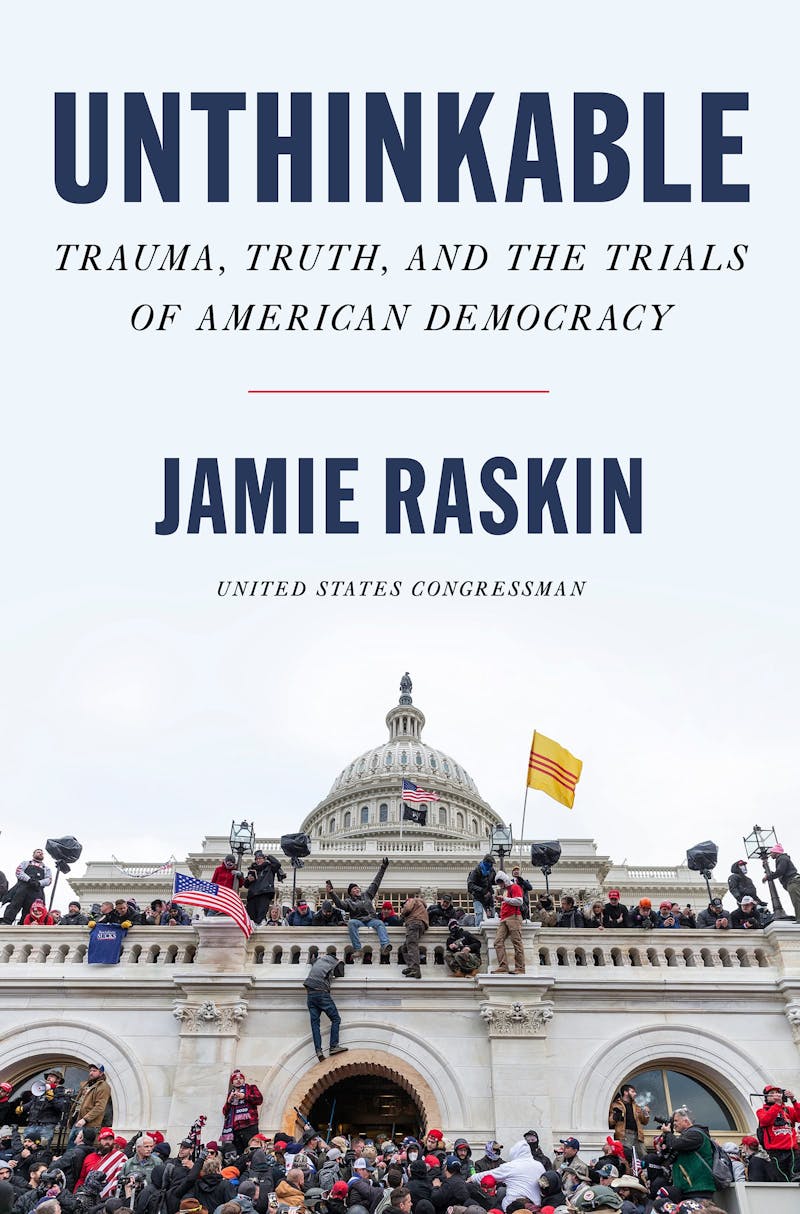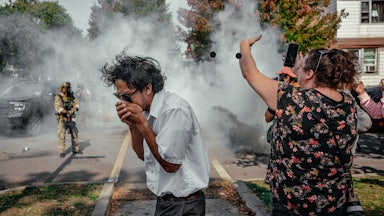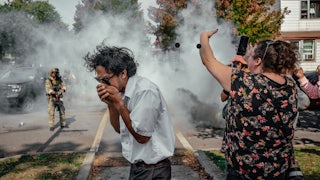From the forthcoming book UNTHINKABLE: Trauma, Truth, and the Trials of American Democracy by Jamie Raskin. Copyright © 2022 by Jamin Raskin. Reprinted by permission of Harper, an imprint of HarperCollins Publishers.

Up to this point, Raskin has described how, at right around 2 p.m. on January 6, 2021, members on the House floor began to get a sense, largely from friends who were watching on television and texted them that they might be in danger. At 2:09 p.m., members received a text from the Capitol Police that said, in part: “All buildings within the Capitol Complex, Capitol: External Security Threat No Entry or Exit.” Someone texted Raskin “the now-iconic photo of the invading insurrectionist casually carrying the Confederate battle flag in the Rotunda, a three-minute walk from where we sit.”
Raskin went to the House that day with his daughter Tabitha and his son-in-law, Hank Kronick, who is married to his older daughter, Hannah. He picks up the narrative from there:
All I can consider now is Tabitha and Hank. I am worried sick for them—they may be the only children of members in the Capitol today—and for Julie, my chief of staff. I call Julie. She says my daughter and son-in-law are okay where they are, behind a locked door, barricaded with furniture in Steny Hoyer’s office. Tabitha and Hank are hiding under Steny’s desk.
“Tell them I love them. Guard them with your life,” I tell Julie. I will learn later that Julie finds a fire poker in Steny’s fireplace and wields it above the door, vowing “I’m not letting these motherfuckers get away with this.” “She definitely got her Philly on,” as Tabitha would explain.
I am picturing them under Steny’s desk and I’m about to call Tabitha to hear her voice—
And then—boom!
Boom!
I hear the sound I will never forget, a sound like a battering ram, the sound of a group of people barreling up against the central door with some huge, hard, thick object, hell-bent on entering the House chamber. The members nearby press furniture up against the door, and a number of us farther away run to the door to help protect it, but we are then quickly told to “get back” by Capitol Police officers, who rush in and defend the entranceway with their guns drawn. The pounding at the door accelerates, and we can hear the sound of angry, macho chanting out there, too.
Hang Mike Pence! Hang Mike Pence!
And: We want Trump! We want Trump!
Someone official calls upon us to evacuate right away, calmly. Everyone moves, some people run, to the Speaker’s lobby, carrying their gas masks. I look up to the gallery again to see our colleagues, who have been frozen in place on the Democratic side, now awkwardly crouching and sliding through the rows to make their way over to the gallery above the Republican side. I see New Hampshire Rep. Annie Kuster and California Rep. Sara Jacobs, who is only in her fourth day on the job, crawling their way over. When we escape and are reunited later, a colleague will tell me they decided to cross over to the GOP side because they thought a mass shooter who entered would be less likely to aim at the Republican side of the House. Meantime, the officers up there have locked all the doors to keep the rioters from breaking in but will now presumably unlock them to get our colleagues out. I feel strange about leaving them up there, but then again, who knows where we’re going? Where will any of us find safety on January 6?
A bloodthirsty mob of hundreds has entered the building outside the metal detectors and with no security check. Who knows what weapons they are carrying? It is hard to displace a thought I have rooted in the images we all carry from the recent Walmart shooting in El Paso; from the 2018 Tree of Life synagogue attack in Pittsburgh; from the 2015 Mother Emanuel AME church massacre in Charleston, South Carolina. What if one of the rioters is carrying an AR-15? Many of us are thinking the same thought.
A handful of officers and young Pelosi staffers—Emma Kaplan, who wrangles members for voting on the floor, is the one I know best and am now looking to for help—leads us higgledy-piggledy down some stairs and into the Capitol tunnels. The members talk madly on their phones. I catch up to Emma and tell her we need to get Tabitha, Julie, and Hank out as quickly as possible. She agrees. She writes a text; she says she will do whatever she can. In the tunnels now, near the tram that runs between the Capitol and the Rayburn House Office Building, we hear shouting, chanting, running, the nauseating buzz of the activated gas masks no one really knows how to work except for some of the military and national security veterans, like Ruben Gallego, Abigail Spanberger, and Jason Crow, who are helping people. Most of the members from the gallery have made it down the stairs and have joined our rapid stream of exit and descent. I hear a southern Republican congressman I know yelling into a phone, “You screwed it up, y’all screwed it all up!” A member tells me that our colleague Raúl Grijalva is having a hard time moving and will be pushed in a wheeled office chair. I look back but don’t see him. I am borne along.
My mind fills with swirling questions as we enter the Longworth Building.
Have we entered a violent power struggle? On our side of the aisle, we have staked everything on popular sovereignty and the mechanisms of democratic election, but Trump and House GOP leaders have been acting on the dictum of the right’s favorite philosopher, Carl Schmitt, who said, “Sovereign is he who decides on the exception.” We have come to the exception. Trump and his enablers have forced us into a politics in extremis, a place where the rule of law is trampled and violence redefines the terrain of struggle to make an authoritarian deviation from the rule of law possible. If the violence of Trump’s own incited mob gets out of hand, he can easily declare a state of siege and impose martial law by activating the Insurrection Act. Will this be his “Reichstag moment,” as General Milley, the chair of the Joint Chiefs of Staff, is apparently wondering too?
We Democrats are in love with the rule of law (which is the control of official abuse of power by formal institutional rules) and with voting and the channels of popular participation to ensure democratic self-government. We have thus looked away from a very old threat suddenly staring us in the face again, the threat that Alexander Hamilton warned us of in Federalist No. 1: the threat of an opportunistic demagogue unleashing a violent mob and primitive impulses against the Constitution to override the political and constitutional infrastructure of representative democracy. The demagogue panders to the negative emotions of the crowd, pretending to be the champion of the people, to wage war against the Constitution, the legal order, and the democratic political process that belong to the people. He starts as a “demagogue,” one who knows how to whip up the crowd into a mob frenzy, but ends as a “tyrant,” a ruler who uses his power to oppress the people, Hamilton said. This scenario is literally in the first Federalist Paper.
And when I say we have overlooked the potential strategic collaboration of mobs and demagogues to demolish our institutions with insurrectionary violence, I mean I. I have overlooked it. How could I have been caught so off-guard? All the clues were staring me in the face. I will face plenty more opportunities in coming days for self-recrimination.
But the question now, as we flee the Capitol from American democracy’s old enemy—racist mob violence—is how our constitutional democracy can prevail over Donald Trump’s party, which operates like a religious cult and couldn’t give a damn about the Constitution or democracy. They are working all the levers of control and violent coercion to keep their leader, his family, and his sycophants in power.
Every part of my past is converging—this struggle will be my life now. As a Maryland congressman who resides in neighboring Montgomery County, I live closer to the Capitol than any other member of Congress (except for my friend Eleanor Holmes Norton, the District’s nonvoting delegate) and I know Washington better than all but perhaps a handful of other members of Congress. We must secure the Capitol and defend our government. We must stop the insurrection, arrest the coup, and punish the lawless—from the inside operators in the corridors of power to the street-level brawlers.
As a professor of constitutional law for three decades, an observer of the separation of powers and civil liberties, and someone who reveres liberal democracy and hates fascism and racism, I have the motivation to fight. I have taken big bipartisan groups of incoming House members to the U.S. Holocaust Museum for a tour before their first session begins, to emphasize the essential stakes of liberal democracy. I send everyone to the National Museum of African American History and Culture and the National Museum of the American Indian to learn about the centrality of slavery, racism, and white supremacy in shaping American politics and defining the American experience.
But, now, I am driven by the memory and spirit of my lost son, who wanted far more from our democracy, not far less. He expressed dread of fascism and what it had done to humanity in the last century and horror for Nietzschean politics based only on “force and fraud and the will to power,” as he used to mutter every time he read the newspaper. He wanted government as the active instrument for promoting the general welfare of not just all human beings but all living beings, and he wanted morality to replace violence as the essence of government power.
I wonder where all this chaos is taking us; whether Tabitha, Hank, and Julie are safe and will be rescued soon; whether I should try to turn back and find officers; whether these insurrectionists have firearms; whether Donald Trump’s allies plan to escalate the violence; whether Sarah, Hannah, and Tabitha’s boyfriend, Ryan, are all right; whether we are facing an insurrection, a coup, or even a civil war; whether we will finally impeach the traitor for setting loose the dogs of war upon us or perhaps invoke, at last, the unsung Twenty-Fifth Amendment; whether dear America will survive this appalling head-first descent into political madness.
I feel curiosity, anger, resolve; but there is one thing I do not feel as we travel down, down, down—“Faster, please hurry,” an officer exhorts us—into the dark complex basement passageways of the Capitol, one thing I don’t sense as we are jostled this way and shepherded that. There is one emotion I have not experienced at all on this persistently gloomy and objectively terrifying day and that I will not experience all through the night: fear.
I feel no fear. I have felt no fear today at all, for we have lost our Tommy Raskin, and the very worst thing that ever could have happened to us has already happened. But I am still in the land of the living, and Tommy is with me somehow every step of the way. He is occupying my heart and filling my chest with oxygen. He is showing me the way to some kind of safety.
My beautiful son is giving me courage as we flee the U.S. Capitol Building for our lives.
My trauma, my wound, has now become my shield of defense and my path of escape, and all I can think of is my son propelling me forward to fight.






